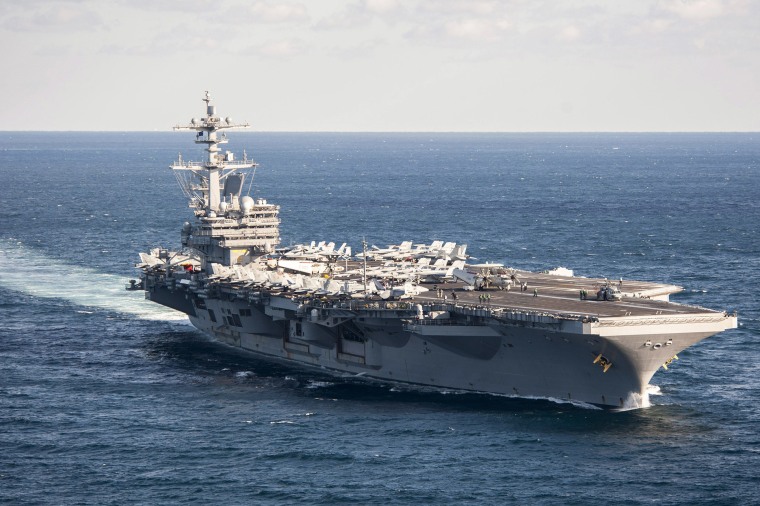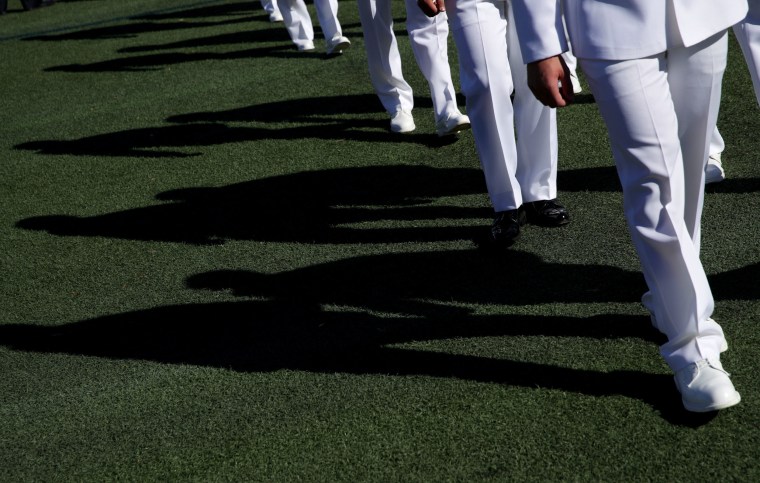By Melissa Chan
From NBC News | Original Article
The number of sailors who deserted the Navy more than doubled from 2019 to 2021, highlighting the lack of options contract-bound sailors face when they’re desperate to leave.
The number of sailors who deserted the Navy more than doubled from 2019 to 2021, while desertions in other military branches dropped or stayed flat, pointing to a potential Navy-wide mental health crisis amid a spate of recent suicides, according to experts and federal statistics obtained by NBC News.
Among a fleet of more than 342,000 active sailors, there were 157 new Navy deserters in 2021, compared with 63 in 2019 and 98 in 2020, Navy data shows. The total number of deserters who were still at large in 2021 grew to 166 from 119 in 2019. Most of them were 25 and younger.
“That’s staggering,” said Benjamin Gold, a defense attorney for U.S. service members.
In the wake of several suicides among sailors assigned to the warship the USS George Washington, the new desertion figures highlight the lack of options for sailors when they’re desperate to leave the military but are bound to multiyear contracts that many of them signed just out of high school.
Military law experts said the nearly unbreakable contracts — which can require up to six years of active duty — leave sailors with extreme alternatives: die by suicide or flee and face harsh consequences, including spending years behind bars as patriots-turned-pariahs.
“They feel trapped,” said Lenore Yarger, a resource counselor with the GI Rights Hotline, a nonprofit nongovernmental group that specializes in military discharges.
‘No easy option’
Of the 152 Navy deserters who were still at large as of May 9, the Navy said, two are from the USS George Washington. One of the sailors deserted the aircraft carrier, which is docked in a Virginia shipyard, about five months ago; the other fled in March 2021.
In the last year, at least five George Washington sailors have died by suicide, three of them within a week last month, military officials said. Several current and former George Washington sailors told NBC News that factors that may have contributed to other suicide attempts were a culture in which seeking help isn’t met with the necessary resources, as well as nearly uninhabitable living conditions aboard the ship, including constant construction noise that made sleeping impossible and a lack of hot water and electricity.

In May 2021, Hannah Crisostomo, an aviation boatswain’s mate handler on the George Washington, attempted suicide on the heels of her first anniversary with the Navy.
Crisostomo had reached her breaking point after having constantly been berated for things that were out of her control. But due to a binding five-year agreement she signed when she was a 17-year-old senior in high school, resigning with two weeks’ notice wasn’t an option.
“There is no easy option,” said Crisostomo, who was on life support for eight days after her suicide attempt. She left the Navy in October on an honorable discharge with a medical condition.

If she stopped showing up to work without permission, the Navy would flag an unauthorized absence, or UA, kicking off a series of grave Navy protocols.
On the fifth day of her absence, she would have stopped getting paid, and her family would have gotten a letter calling for her immediate surrender. After 30 days — or earlier if leaders had reason to believe Crisostomo didn’t intend to return or was high risk — she would have been declared a deserter. Crisostomo would have been entered into the FBI’s wanted persons database, and a federal warrant would have been issued for her arrest.
Any traffic stop while she was on the run could have ended in her return to the Navy, which could then have punished her with jail time or a court-martial. And because there is no statute of limitations, the Navy could have chosen to pursue her forever.

Nearly 150 deserters were returned to the Navy last year, the most in the last five years, data shows. Fifty-nine deserters were returned in 2020, compared with 79 the year before.
During wartime, the most severe punishments for desertion are death and up to life in prison, said Lt. Cmdr. Devin Arneson, a Navy spokesperson. In other times, a deserter could face a range of penalties, including up to five years’ confinement.
Beyond criminal charges, sailors considering desertion worry they will ruin their reputations, doom future career prospects, bring shame to their families and be seen as cowards — all of which sailors may fear more than any time in the brig, military law attorneys said.
“It’s not just any sort of offense,” said Stephen Karns, a Dallas-based military law attorney. “It’s like you gave up on your country.”

In 2020, the most recent year for which full data is available, 580 military members died by suicide, a 16 percent increase from 2019, when 498 died by suicide, according to the Defense Department. Nineteen of every 100,000 sailors died by suicide in 2020, compared to members of the Army, which had the highest rate, at about 36 per 100,000, Pentagon statistics show.
Navy suicides decreased slightly from 74 in 2019 to 66 in 2020, Pentagon statistics show. But Karns said that doesn’t mean there isn’t a mental health problem. It could mean more sailors are choosing to desert rather than kill themselves, he said, or it could indicate that more are getting successful inpatient treatment.
Meanwhile, Army desertions have steadily declined since 2019, as its workforce has grown. There were 174 Army desertions last year — a reduction from 291 in 2020 and 238 in 2019, said Sgt. 1st Class Anthony Hewitt, an Army spokesperson.
Desertions within the Marine Corps also dropped, from 59 new deserters in 2019 to 31 in 2021. The Coast Guard said there were no deserters from 2017 to 2021, and Air Force figures remained steady.
Navy officials struggled to explain the increase in desertions, saying sailors can be exposed to “many different stressors.” Arneson said the reasons people choose to take extreme actions are personal. “We don’t want to guess at someone’s motives,” she said.
But military law experts said the rise isn’t surprising, given how significantly mental health often plays a role when service members abandon their posts.
Karns said mental health issues have factored into almost every one of the 1,000 unauthorized absence or desertion cases he has handled, more than 150 of them from the Navy. The average age of his clients in those cases is 25 and below.
“The military can be a great place,” he said. “But if you don’t like it for whatever reason, it can be a very suffocating and miserable place.”
Unlike in the civilian world, where people can seek mental health care without their employers knowing and get quicker consultations, sailors have to inform their superiors and wait for the next available appointments with military medical providers, which can take several weeks.
Before the suicides in April, there had been only one psychologist on the George Washington to serve about 2,700 people.
“In the military, it’s get in line,” Karns said. “They have no problem telling you, well, you can’t get in until next month, and guess what? Your follow-up appointment is not for another month, either.”

Yarger said many of the calls she fields with the GI Rights Hotline are from sailors who desert because they need mental health care they aren’t getting. “Either I go back on the ship and I risk hurting myself, or I go UA,” Yarger said, recalling the sailors’ remarks. “It’s something we get too many calls about.”
The Navy said sailors experiencing mental hardships caused by external issues, such as family members’ health, can separate early under voluntary administrative options.
Experts said it’s a lengthy and nearly impossible recourse to exit early for being mentally unfit, because of a “cry wolf” effect on ships. Karns said that because so many sailors make that claim to leave, on-base military medical providers have the tough task of determining which sailors are genuinely in need and which may be abusing the system.
For those who desert and are returned to face consequences, several military law attorneys and counselors said, the Navy commonly uses administrative or noncriminal proceedings to separate them on other-than-honorable terms, which is less severe than a dishonorable discharge.
Such proceedings are more convenient for the command and less punishing for sailors, but other-than-honorable discharges could stymie future employment in law enforcement or within the federal government and affect service members’ ability to retain medical benefits, disability compensation and other privileges afforded to veterans.
If a service member deserts or is absent without official leave for a continuous period of at least 180 days, the Department of Veterans Affairs can’t provide benefits, unless it’s determined that the service member was insane at the time, according to the agency.
“It can seem like the right thing to do at the moment, because you’re desperate to get care,” Yarger said. “But it can really have a long-term effect on a person and their family.”

Too young for such a big decision?
Young sailors may not be thinking that far ahead. From 2019 to 2021, the average active-duty enlisted age was 21.6 years, said Lt. Rachel Maul, a spokeswoman for the chief of naval personnel.
Yet researchers have found that the human brain, particularly the part responsible for planning and controlling impulses, doesn’t finish developing and maturing until the mid- to late 20s, according to the National Institute of Mental Health. That is partly why critics oppose military recruitment campaigns in high schools.
“It’s hard for a young person at that age to grasp the amount of power and control that their employer has over their lives,” said Rick Jahnkow, an organizer with the National Network Opposing the Militarization of Youth, a nonprofit group. “They don’t understand the commitment.”
Karns agreed, saying recruiters often aren’t fully transparent about what military life entails. That may be especially true for the sailors assigned to the George Washington, which has been undergoing extensive repairs at the Newport News Shipyard in Virginia since 2017.
During such overhauls, according to several sailors, most crew members are relegated to clean-up and repair tasks rather than the jobs they enlisted to do.
The Navy said junior sailors make up about 95 percent of the roughly 2,700-member crew. Many are leaving their family homes for the first time.
“These sailors are fresh out of boot camp,” said a sailor who still works on the warship and asked to remain anonymous out of fear of retaliation. “They’re thinking they’re gonna see the world, Japan, Guam, and they’re stuck on this piece of s—, going nowhere, just sitting there.”
In February, a report by the Government Accountability Office identified several challenges affecting sailors during maintenance periods. Crew members from more than a dozen ships, including submarines and aircraft carriers, described working up to 20-hour shifts in unsafe conditions amid workforce shortages.
Since the three suicides in April, the Navy has offered to relocate hundreds of George Washington sailors who live onboard into nearby military housing facilities. As of May 13, the Navy said, more than 280 sailors have taken the offer while it works to secure additional accommodations for the remaining crew.
Yarger said sailors may struggle because it’s difficult to imagine life on a ship or how they’re going to respond to such conditions until they experience them.
While there is an option for sailors to separate from the Navy because they’re unable to adjust to the environment, military law attorneys said, that would typically occur during the training period. By the time many of the sailors leave boot camp and get their orders, it’s too late to back out.
At that point, said Gold, who was a naval officer for nearly seven years, serving can start to feel like being in prison.
“It’s a harsh reality,” he said. “They think there’s nothing else, that a deal is a deal. It’s problematic when the light at the end of the tunnel is five years out.”

